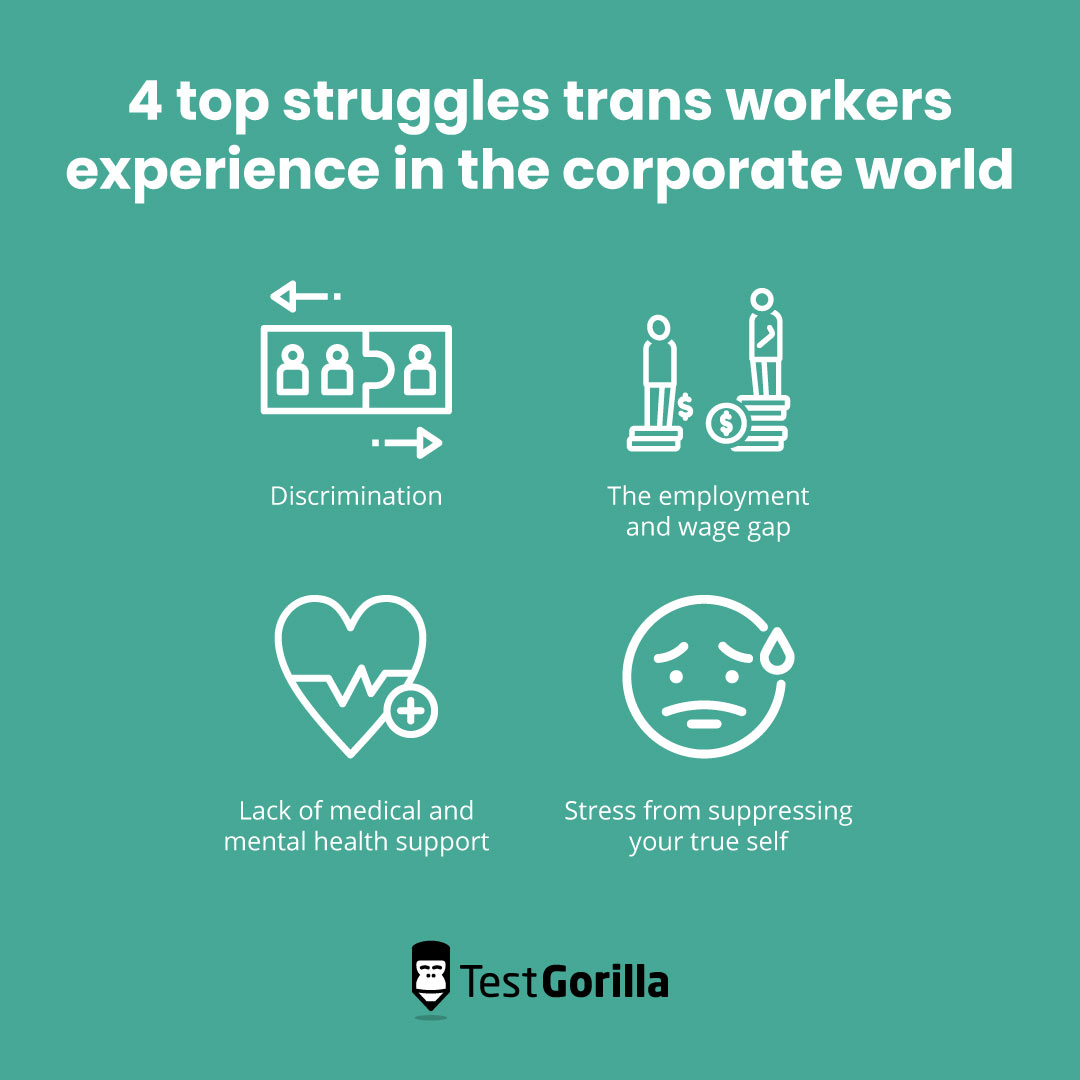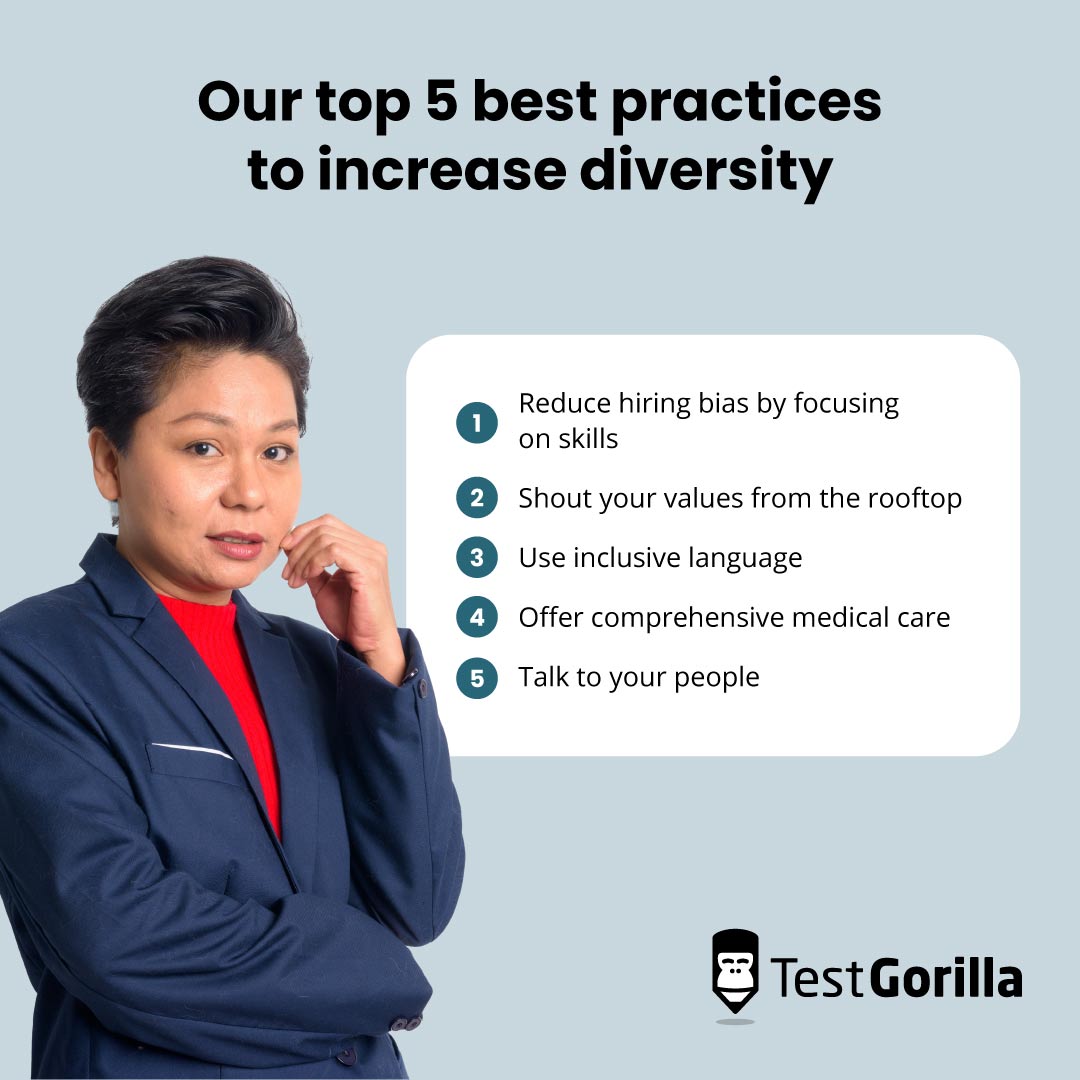The barriers trans people face in the workplace as candidates and employees
We’ve spoken about the importance of LGBTQ+ inclusion in the workplace, although few companies make targeted efforts to specifically improve the experience of transgender candidates and employees.
Nearly 30% of transgender people are not in the workforce and are twice as likely as cisgender people to be unemployed.[1]
This employment gap is startling, and it stems from many damaging issues that the trans community faces every day at work, including dangerous harassment, a shocking wage gap, and intense mental stressors, including depression and anxiety.
If organizations want to include trans applicants in their DEI initiatives, they must address these issues and create a safe, inclusive company culture.
This article discusses the many barriers that trans people face before and after hiring and how you can adopt positive best practices to improve the process.
We also discuss the disappointing lack of research on this disadvantaged community and how this damages diversity efforts and support.
Table of contents
The barriers trans people face in the corporate world
Trans people face several challenges in the working world, and they follow them throughout the entire experience, from hiring to the employee experience.
Here’s a quick summary of the top struggles trans workers experience:
Discrimination
The employment and wage gap
Lack of medical and mental health support
Stress from suppressing your true self
Discrimination
Discrimination is by far one of the worst issues the trans community faces. It stems from conscious and unconscious bias and can escalate to physical harassment.
A study by UCLA found that more than 40% of LGBTQ+ workers in the US report experiencing unfair treatment at work, including not being hired, getting fired, or being harassed.
When you break this number down into transgender people and cisgender people, it gets worse.
The same study shows that 48.8% of transgender employees reported experiencing discrimination based on their LGBTQ+ status, compared with 27.8% of cisgender LGB workers.
Further, 43.9% of transgender employees reported not being hired because of their LGBTQ+ status compared with 21.5% of cisgender employees.
A separate study by McKinsey & Company, “Being transgender at work,” found that transgender people feel far less supported in the workplace than their cisgender colleagues do.
They report that it is harder to understand workplace culture and benefits, feel less supported by their managers, and find it more difficult to get promoted.[2]
Another aspect of discrimination that hinders trans workers is the fear of harassment, which often leads to physical violence and bullying. Trans people are more than four times as likely to experience violent victimization than their cis counterparts.
Read our blog on disparate impact and disparate treatment for more information on this topic.
The employment and wage gap
As previously mentioned, nearly 30% of trans people aren’t in the workforce. In contrast, the unemployment rate for white cisgender males is 3.3%.
This shocking gap results from many of the other challenges listed here – in other words, many trans people find it difficult to find and maintain a solid job owing to discrimination, stress, and mental health issues.
Unfortunately, this employment gap comes with an unfair wage gap.
The same McKinsey & Company study mentioned above found that cisgender workers make 32% more money yearly than transgender employees, even when the latter have similar or higher education levels.[2]
And they aren’t the only ones who discovered a wage gap. A separate survey done by the Human Rights Campaign found:
Transgender women earn about 60 cents for every dollar the typical worker earns.
Non-binary, genderqueer, genderfluid, and two-spirit workers earn about 70 cents for every dollar the typical worker earns.
This survey also found that all types of LGBTQ+ women earned less than men, including LGBTQ+ men.
For more insights on this topic, read our article on the gender employment gap.
This wage gap directly correlates to the above-average amounts of transgender adults living in poverty. A recent study showed that 21% of transgender adults lived in poverty in 2021 versus 12% of straight, cisgender adults.
This disparity in wages isn’t just unfair on a moral level. It also affects your trans workers’ engagement at work, reducing their satisfaction and performance overall.
Lack of medical and mental health support
Proper medical and mental health support is important for all employees, but you should pay special attention to trans workers for two big reasons:
Their medical needs could be different than those of cisgender employees
Their mental health issues could be more intense and frequent than cisgender workers
Let’s talk about point two. Research shows that transgender people suffer higher rates of depression and anxiety. According to Health Partners, 85% of transgender Minnesotans feel depressed weekly, and 36% experience depressive thoughts five days a week.[3]
In comparison, only 5-6% of the general population experiences regular feelings of depression.
Another study by Transgender Health found that trans people (58%) are four times more likely than cisgender people (13.6%) to have a mental health condition.[4]
These numbers mean that a crucial part of maintaining employee wellbeing for trans workers is supporting their mental health.
It’s also imperative to give them easy access to gender-affirming medical care. But we’ll talk about that in-depth later.
Stress from suppressing your true self
Countless trans workers feel stressed from suppressing their true selves and suffer anxiety, wondering whether or not to out themselves.
There’s an underlying pressure of whether or not to tell co-workers or managers about your gender identity, and it’s always on your mind.
According to McKinsey, more than half of transgender employees say they are not comfortable being out at work, and two-thirds of transgender people remain closeted in professional interactions outside their own companies.[2]
This stress affects more trans people than we could ever count because many choose to remain closeted for safety reasons.
A personal example is the story of a non-binary friend who goes by they/them pronouns with friends but has never mentioned them at work. They say:
“It’s just too hard to go through. You don’t know how they’ll react, so it’s easier to swallow being misgendered.”
These people could be at your workplace right now, feeling stressed and without support because they fear coming out.
There isn’t enough research on being trans in corporate spaces
The above challenges are only the tip of the iceberg – they’re the only issues we’ve found hard data about, but there’s so much more below the water’s surface.
Research and reporting need to change to scientifically uncover the issues faced by transgender applicants and workers and help employers tackle them.
Official research impacts action. DEI studies and company initiatives often overlook transgender diversity, and solid research is necessary to make a business case and charge your DEI initiatives effectively.
A discussion of these points appears in an article written by Caitlin Carroll, a transgender and intersex marketing professional, who addresses how a lack of research harms transgender equity.
She discusses the McKinsey report “Being transgender at work” and says it’s the largest report on being trans in the workplace, but it only had 250 respondents.
Caitlin adds that the largest study about transgender experiences was the 2015 US Transgender Survey – and this study only included 27,000 respondents, despite the 1.6 million trans voices in the US.[5,6]
This lack of knowledge hurts transgender equity because, without the research, companies don’t know what challenges are confronting their trans employees.
Further, they don’t know how to put a stop to them.
Although with the knowledge we do have, we can offer these best practices.
What you can do to create an inclusive experience process for trans candidates and employees
However limited the research, organizations can create a safe, inclusive process for hiring, onboarding, and employing trans candidates.
While we don't have all the research and answers we need, companies can follow the lead of trailblazers to help build an inclusive environment for transgender and other LGBTQ+ people.
According to TestGorilla’s State of Skills-Based Hiring report, 76.8% of companies aimed to increase diversity in 2022.
But this goal can’t be a reality unless you take meaningful steps to include transgender applicants.
Here’s a quick summary of our top best practices:
Reduce hiring bias by focusing on skills
Shout your values from the rooftop
Use inclusive language
Offer comprehensive medical care
Talk to your people
1. Reduce hiring bias by focusing on skills
The traditional hiring process leaves room for bias and discrimination against transgender candidates, particularly in name and appearance.
For example, some employers require or request photos on a resume.
Something as simple as a name doesn’t seem like it should be an area of discrimination, but an individual’s name on an application can imply LGBTQ+ or trans identity.
Many LGBTQ+ individuals, particularly non-binary people, pick unique gender-neutral names, like Granite and Nebula.
Bias against how a name sounds is also one of the major issues around the gender application gap.
We recommend using anonymous applications – or dropping applications entirely and relying on skills-based hiring.
Skills-based hiring reduces hiring bias by using objective skills tests and by removing resumes and reliance on work history and education.
Can education requirements damage opportunities for trans applicants? Studies suggest they can.
One study found that 16% of trans people dropped out of college owing to extreme harassment. There could be fewer trans people with college degrees, so requiring them could be filtering trans people out of your hiring process.[7]
Skills-based organizations focus on what candidates bring to the table skill-wise. Can you get the job done? You get the job.
This approach helps eliminate a “fake it till you make it” mindset, reducing bias and encouraging trans applicants to apply freely.
2. Shout your values from the rooftop
One of the biggest things you can do as a company is to take a firm, loud stance on LGBTQ+ rights.
As a trans individual, it’s terrifying and stressful to apply for a job and go through the hiring process constantly thinking:
“Should I be out? Are they looking for diverse candidates? Would my identity be beneficial? Or should I stay in the closet because my identity will harm my chances of getting the job?”
When a company is open about its policies regarding LGBTQ+ candidates, specifically trans candidates, it can alleviate this fear, leading to a larger number of diverse applicants.
Clearly showing your values also helps attract LGBTQ+ candidates who aren’t sure if your company is merely a “brand activist” (i.e., taking part in a cause because it’s trendy or expected by society, but without truly embracing the values).
IBM is one famous example of a company that loudly shows its commitment to LGBTQ+ inclusion. Its LGBTQ community page displays its LGBTQ+ workers, the charities it’s partnered with, and educational content.[8]
Trans inclusivity matters to other people, too.
Thousands of applicants, clients, and stakeholders appreciate an inclusive mindset. One example is Anya Overmann, an editor who declined a much-needed client because she discovered the client was judgmental and aggressive towards the trans community.[9]
Anya said: “I would rather be broke than help a bigot.”
3. Use inclusive language
To use inclusive language is to be mindful of the phrases and wording you use at work. Language is unconsciously coded in one person’s favor or against someone else’s.
For example, a job description that says, “He/she must be able to manage a team of 10 sales representatives,” unintentionally excludes those that use they/them pronouns.
The moment you start using inclusive language, it communicates to transgender people that they are welcome in your organization. It’s another way to tell candidates your values and stance on inclusivity.
Inclusive language helps trans applicants know they can be safe and successful at your company.
Here are a few tips for using inclusive language:
Avoid gendered language in job descriptions and job ads, including gendered job roles (salesperson > salesman)
Use they/them pronouns until a candidate specifies their pronouns
Use gender-neutral terms in work documentation and daily use, such as “parental leave” instead of “maternal leave”
Tell candidates your pronouns through email or during the interview and ask for theirs – never assume
We recommend adding employee pronouns to email signatures, Slack profiles, and anywhere else your company gets work done. It’s not only efficient, but it’s also respectful to all your employees.
Check out our diversity, equity, and inclusion glossary for more information on inclusive terminology.
4. Offer comprehensive medical care
Medical care is a standard, traditional employee benefit that nearly every workplace provides, but it’s rare to see an organization offer trans-inclusive medical support.
Companies should be providing support for surgeries, hormone therapy, and other gender-affirming care. These things aren’t “nice to have” for trans people. They’re lifesaving and necessary.
An article by Taylor Sprague, a senior manager at Jobs for the Future, discusses the importance of employer-supported gender-affirming care. They especially ask for the attention of companies that commit to diversity.
We believe Taylor’s message comes through clearly in this powerful quote:
"If you are not providing these options as an employer, you inherently limit the number of transgender and non-binary people who can genuinely consider working for your company."
Taylor says that many employers have only three options on medical and insurance forms: man, woman, or “prefer not to say.”
They add that the “prefer not to say” often defaults to “man” when chosen, which can cause issues down the road when trying to access medical care (something that happened to Taylor at their workplace).[10]
A real-life example of a company implementing this is Accenture, a global software and IT company. It’s known for its commitment to DEI and offers trans-inclusive health care in 17 countries, which accounts for 95% of its people.[11]
5. Talk to your people
Talking to your workers is simple but powerful.
One of the most effective ways to help your trans workers is to talk to them. Inquire about their mental health and ask what they need during regular 1:1 meetings.
These meetings are a great opportunity to ask them about their needs and where they need support and listen and implement feedback wherever possible.
For example, if a trans employee asks you about development due to a lack of extensive work experience, you can help them pursue upskilling opportunities to help their professional growth.
Talking with your workers also means supporting them and trying to stop toxic colleagues if they experience bullying.
It’s important to listen when trans employees tell you about discrimination, whether it’s serious bullying or perceived harassment. Trans people know their experiences, and they know what hurt them.
For example, a colleague could accidentally use the wrong pronouns, which is still painful for the trans employee. It’s crucial to step in and have a constructive talk with the other worker.
Support trans candidates by hiring for skills
The trans community faces unprecedented challenges in the working world, including discrimination, an employment gap, and a lack of medical support.
What’s worse, existing research has wide gaps, so we don’t know the full extent of their struggles.
We ask for more studies on the trans community at work and also for companies to do whatever they can to create a better experience for trans workers.
You can promote trans equity and alleviate these challenges by adopting skills-based practices, wearing your values on your sleeve, and offering much-needed healthcare support.
For more information on creating an equal and fair workplace, read our blog on why you should prioritize inclusiveness.
To get started with skills-based hiring, look at more than 300 skills tests in our test library.
Sources
"Transgender people twice as likely to be unemployed". (December 15, 2021). McKinsey & Company. Retrieved June 8, 2023. https://www.mckinsey.com/featured-insights/sustainable-inclusive-growth/chart-of-the-day/transgender-people-twice-as-likely-to-be-unemployed
"Being transgender at work". (November 10, 2021). McKinsey & Company. Retrieved June 8, 2023. https://www.mckinsey.com/featured-insights/diversity-and-inclusion/being-transgender-at-work
"Understanding mental health in the transgender community". (2022). Health Partners. Retrieved June 22, 2023. https://www.healthpartners.com/blog/mental-health-in-the-transgender-community/
Wanta, Jonathon W., et al. (2019). "Mental Health Diagnoses Among Transgender Patients in the Clinical Setting: An All-Payer Electronic Health Record Study". Transgender Health. Retrieved June 22, 2023. https://www.liebertpub.com/doi/pdf/10.1089/trgh.2019.0029
Carroll, Caitlin. (May 16, 2023). "The Lack of Transgender Inclusion Harms Our Equity Conversations". LinkedIn. Retrieved June 8, 2023. https://www.linkedin.com/pulse/lack-transgender-inclusion-harms-our-equity-caitlin-carroll/
Allen, Jonathan. (June 10, 2022). "New study estimates 1.6 million in U.S. identify as transgender". Reuters. Retrieved June 22, 2023. https://www.reuters.com/world/us/new-study-estimates-16-million-us-identify-transgender-2022-06-10/
"Transgender Students in Higher Education". (August, 2018). UCLA. Retrieved June 22, 2023. https://williamsinstitute.law.ucla.edu/publications/trans-students-higher-education/
"LBGTQ+ Community". IBM. Retrieved June 22, 2023. https://www.ibm.com/impact/be-equal/communities/lgbtq/
Overmann, Anya. (June 4, 2023). "Business or Transgender Rights? I Chose the Latter". LinkedIn. Retrieved June 8, 2023. https://www.linkedin.com/pulse/business-transgender-rights-i-chose-latter-anya-overmann/
Sprague, Taylor. (June 7, 2023). "What Employers Can Do to Expand Access to Gender-Affirming Care for Transgender and Nonbinary Employees". LinkedIn. Retrieved June 8, 2023. https://www.linkedin.com/pulse/what-employers-can-do-expand-access-gender-affirming-care-sprague/
"Pride at Accenture". Accenture. Retrieved June 22, 2023. https://www.accenture.com/us-en/about/inclusion-diversity/lesbian-gay-bisexual-transgender
Related posts
Hire the best candidates with TestGorilla
Create pre-employment assessments in minutes to screen candidates, save time, and hire the best talent.
Latest posts
The best advice in pre-employment testing, in your inbox.
No spam. Unsubscribe at any time.

Hire the best. No bias. No stress.
Our screening tests identify the best candidates and make your hiring decisions faster, easier, and bias-free.
Free resources
This checklist covers key features you should look for when choosing a skills testing platform
This resource will help you develop an onboarding checklist for new hires.
How to assess your candidates' attention to detail.
Learn how to get human resources certified through HRCI or SHRM.
Learn how you can improve the level of talent at your company.
Learn how CapitalT reduced hiring bias with online skills assessments.
Learn how to make the resume process more efficient and more effective.
Improve your hiring strategy with these 7 critical recruitment metrics.
Learn how Sukhi decreased time spent reviewing resumes by 83%!
Hire more efficiently with these hacks that 99% of recruiters aren't using.
Make a business case for diversity and inclusion initiatives with this data.






















